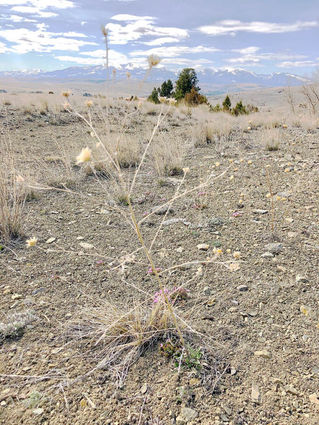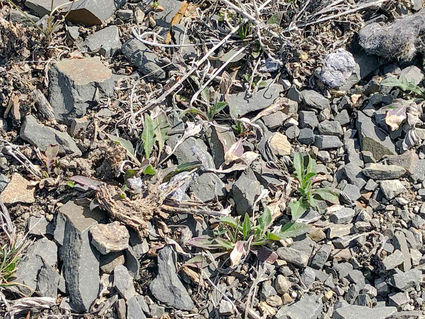By Karen Laitala, Vegetation Coordinator

The past few weeks I have been making a concerted effort to take daily walks on the ranch where I live. Last week the snowy path I wandered gave way to a spring melt off event. By mid-week I sighted my first wildflower blossoms. Yet even before the snow cleared, I had begun to see spotted knapweed rosettes emerging at the base of last year’s seed heads as well as scattered seedlings.
With temperatures reaching the mid to upper 60’s, I started to experience an increase in questions about weed management projects and methodology as well as a request to borrow spray equipment. As predicted, temperatures dipped dramatically by the weekend and a significant amount of snow accumulated. Several things came to mind including weather effects on invasive plants, seed longevity in the soil and herbicide application timing.
Spotted knapweed behaves as a biennial or short-lived perennial in Montana. It produces a rose patterned set of leaves close to the ground during its early growth stage. Later in the season it may produce flowering stems that can reach a height of up to six feet and each knapweed plant may bloom and set seed the first year, the second year or for a few consecutive years. These factors are most likely influenced by growing conditions including access to varying amounts of sunlight, moisture and nutrients.
The biggest contributing factors to certain plants’ invasive abilities are a favorable environment, successful and highly competitive use of available resources and extremely prolific reproduction capabilities. In the case of the spotted knapweed I encountered, I saw evidence of new growth long before any other plant around, indicating that these plants will utilize more growing space, moisture, sunlight and nutrients earlier thereby limiting the native and desirable grasses, wildflowers and shrubs that will emerge and develop later. When temperatures rise and the soil becomes drier, the long taproot of these knapweed plants will be able to access moisture from much deeper in the soil that many other plants.
Often blooming as long as early summer into late fall, each spotted knapweed plant can produce around 1,000 seeds that are known to retain the ability to germinate in the soil for as long as eight years.
Last but not least, spotted knapweed plants are suspected to exude toxins that inhibit the growth of neighboring plants, thereby increasing the span of their environment and upping the chances of success for their “offspring.”
While the nature of spotted knapweed lends itself to early season management techniques including hand pulling and herbicide treatments, understanding how cold weather limits herbicide capability is an important aspect of early season applications. Most herbicide labels dictate that daytime temperatures must reach at least 50° prior to application. Ineffective herbicide applications, due to cold weather, are common when nighttime temperatures dip below 40°. When the temperature drops, it is more difficult for plants to metabolize moisture and nutrients from the soil and this same situation makes it harder for weeds to absorb herbicides. Cold weather also slows plant growth and hardens cell walls, negatively affecting uptake of the herbicide.

Post-emergent herbicide applications often include the use adjuvants to improve efficacy and on-target application, helping the herbicides utilized provide maximum weed control. Applicators using adjuvants with herbicide applications early in the season need to be prepared for how the lower temperatures may affect the adjuvant solutions during the application. Adjuvants can be very sensitive to cold temperatures and are prone to freezing when exposed to temperatures below 25°. Since adjuvants have a higher viscosity (or thickness and stickiness) in cold temperatures, applicators need to plan these applications carefully to make sure the product is effective and to avoid herbicide injury to unintended targets. Optimal temperatures for adjuvant use is above 60° and they too are less effective when nighttime temperatures fall to 40° or below.
Spring weather is not always cooperative and can lead to frustration when herbicide applications are ineffective. By understanding how herbicide applications that may include adjuvants perform in cooler temperatures, applicators and growers can implement a more effective weed management plan that will help crops, pastures and rangelands realize maximum health and yield potential. Fortunately, or unfortunately (!), due to its vigorous growth potential, spotted knapweed can be successfully treated throughout the growing season.
